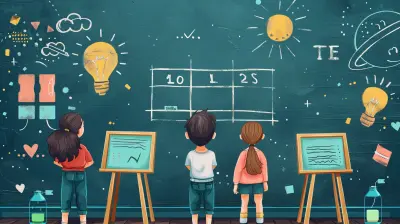14 April 2025
Ever stared at a long list of information and thought, “How in the world am I going to remember all this?” Trust me, we’ve all been there. Whether you're cramming for an exam, prepping for a big presentation, or just trying to improve your memory, mastering the art of memorization can be a game-changer.
But here’s the thing—our brains aren’t designed to remember long, boring lists naturally. The good news? There are powerful techniques that can help you recall information faster and more effectively. Let’s dive in and uncover the best memory-boosting strategies that will make memorizing long lists a breeze!

1. The Power of Chunking
Ever noticed how phone numbers are grouped into smaller chunks? That’s because our brains find it easier to remember small bits of information rather than a long, continuous string. This technique is called chunking, and it works wonders for memorization.How to Use Chunking:
- Break your list into smaller groups of 3-5 items.- Find connections between the items in each group.
- Use a meaningful pattern, like grouping words based on categories.
For example, if you're trying to memorize a shopping list—apples, milk, bread, chicken, pasta—you might group them like this:
- Fruits/Dairy: Apples, Milk
- Grains/Bakery: Bread, Pasta
- Proteins: Chicken
Chunking simplifies the information, making it much easier to recall.

2. The Memory Palace Technique (Method of Loci)
Picture your house. Now imagine walking through each room, placing different pieces of information in specific spots. Later, when you need to recall them, you mentally walk through your house and "pick up" the items where you left them.How It Works:
1. Choose a familiar place (like your home).2. Assign each item from your list to a specific location in that space.
3. As you mentally walk through the place, visualize the items in those spots.
For example, if you're trying to remember a list of historical events, you might picture the signing of the Declaration of Independence happening in your kitchen, and the invention of the light bulb taking place in your living room. The more vivid and bizarre your mental images, the better!

3. Acronyms & Acrostics: Make It Stick with Mnemonics
Acronyms and acrostics are some of the easiest ways to remember long lists. An acronym takes the first letter of each word in your list and forms a new word. Meanwhile, an acrostic creates a phrase where each word starts with the same letter as the item you need to remember.Example:
To memorize the Great Lakes (Huron, Ontario, Michigan, Erie, Superior), use the acronym HOMES.Or, if you need to remember the order of mathematical operations (Parentheses, Exponents, Multiplication, Division, Addition, Subtraction), use the acrostic:
"Please Excuse My Dear Aunt Sally."
These tricks are fun, easy to create, and incredibly effective.

4. The Peg System: Attach Words to Numbers
The peg system assigns words to numbers, helping you recall lists in a specific order. Each number is linked to an easy-to-remember word or image, and you "hang" the items you want to remember onto these mental pegs.How to Use It:
1. Create a peg list using rhyming words for numbers (e.g., 1-Sun, 2-Shoe, 3-Tree).2. Create a mental image combining the peg and the information you're memorizing.
For instance, if you're remembering a to-do list and need to buy eggs (1st item), you might visualize eggs frying on a sun. If you need to call a friend (2nd item), picture a giant shoe dialing a phone. The sillier the image, the better it sticks!
5. Storytelling: Turn Information into a Narrative
If you love stories, this one's for you! The human brain is wired to remember stories much better than random lists. Instead of memorizing items individually, weave them into a story.Example:
Say you need to remember these words: dog, book, pizza, airplane, and ocean. You could create a story like this:"A dog was reading a book about pizza while flying an airplane over the ocean."
The crazier and more vivid your story, the easier it'll be to recall the list later.
6. Visualization: Make It Picture-Perfect
Our brains love images! Associating information with mental pictures can significantly boost your memory. Try converting each item on your list into a strong, exaggerated visual image.Example:
If you need to remember a list of planets (Mercury, Venus, Earth, Mars, Jupiter), picture:- Mercury as a melting metallic ball.
- Venus as a heart-shaped planet (like love and beauty).
- Earth as a giant blue marble.
- Mars as a fiery red battlefield.
- Jupiter as a massive gas giant with a stormy eye.
The more vivid and outlandish your images, the better they’ll stick in your mind.
7. Repetition & Spaced Learning
Memorization isn’t a one-time event—it’s a process. Studies show that spaced repetition, reviewing information at gradually increasing intervals, is one of the most effective ways to retain it long-term.How to Use Spaced Repetition:
1. Review your list immediately after learning it.2. Review again after 15-30 minutes.
3. Repeat after a few hours, then the next day, then a few days later.
Apps like Anki or Quizlet use this technique to help you retain information effortlessly.
8. Rhymes & Songs: Make It Musical
Have you ever noticed that you can remember song lyrics from years ago but forget what you studied last night? That’s because music helps cement information in our memory.Creating a simple rhyme or setting your list to a familiar tune can make memorization much easier.
Example:
Need to remember the number of days in each month? Sing:"Thirty days hath September, April, June, and November…"
Making your own memory tunes can turn a dull list into something unforgettable!
9. Teach It to Someone Else
Want to know the best way to test your memory? Teach the information to someone else! The Feynman Technique, named after physicist Richard Feynman, states that if you can explain something in simple terms, you truly understand and remember it.Steps to Use This Technique:
1. Learn the information.2. Try explaining it to someone (or pretend you're teaching).
3. If you get stuck, go back and refine your understanding.
Teaching forces you to process information deeply, making it harder to forget.
10. Using Association: Link New Info to What You Already Know
Connecting new information to something already in your memory strengthens retention. This is called associative learning.Example:
If you need to remember that "Hippocampus" is a part of the brain responsible for memory, picture a hippo on campus, studying hard and trying to memorize things. The funny mental picture makes it harder to forget!Final Thoughts
Memorizing long lists doesn’t have to be painful or frustrating. With the right techniques—whether it’s chunking, storytelling, creating mental images, or using songs—you can turn even the most daunting list into something easy to recall.So, which technique are you going to try first? Whatever method you choose, practice makes perfect. The more you train your brain, the sharper your memory becomes. Happy memorizing!




Anabella Miller
Great article! Simplifying complex information through techniques like chunking and visualization really enhances retention. Practical tips like these make memorizing long lists much more manageable!
April 15, 2025 at 12:12 PM